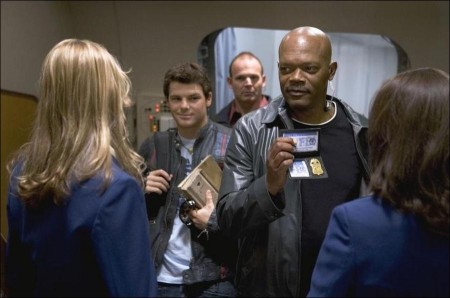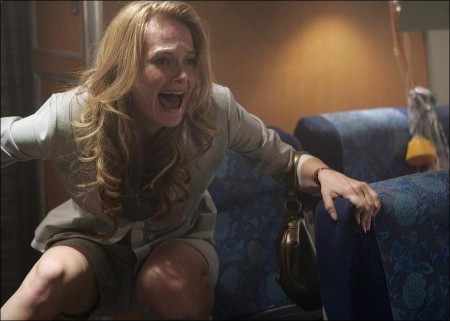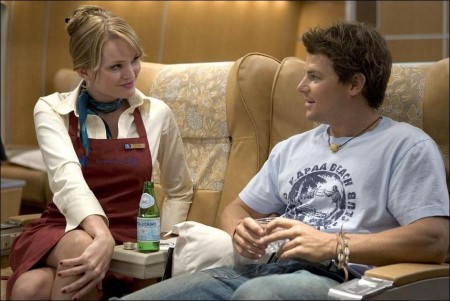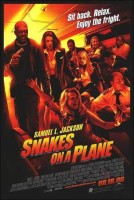Tagline: Sit back. Relax. Enjoy the fright.
After witnessing gangster Eddie Kim brutally beat U.S. Prosecutor Daniel Hayes to death in Hawaii, Sean Jones is escorted by FBI agents Neville Flynn and John Sanders on a Boeing 747-400 to testify in a trial in Los Angeles. Despite increased security for the flight, Kim arranges for a time-release crate full of venomous snakes to be placed in the cargo hold in an attempt to bring down the plane before it reaches Los Angeles International Airport (LAX).
To ensure the snakes attack the passengers without being provoked, he has one of his henchmen disguised as an airport ground employee spray the passengers’ leis with a special pheromone which makes the snakes highly aggressive in their attack. The crate opens midway through the flight and the snakes make their way through the cabin. A cat in the cargo bay, a couple having sex in the bathroom, and a man using the bathroom are the first killed. The plane’s captain, Sam McKeon, investigates and fixes an electrical short, but is killed by the viper that caused it. Co-pilot Rick, unaware of the snake, believes Sam has suffered a heart attack and continues toward LAX.
Snakes on an Urban Myth
With the tremendous interest and rabid fan base that sprung up from the moment Snakes on a Plane went into production, it was inevitable that more than a few urban myths would develop around the film. Here’s a look at some of the most common misconceptions.
FICTION: The original title for Snakes on a Plane was Pacific Air 121.
Berenson’s assistant, John Heffernan, sparked to the idea and penned a new version of the story which would eventually be called Pacific Air 121 for a brief period of time before settling on its ultimate title – Snakes on a Plane.
FICTION: The famous Samuel Jackson line that was added to the film is “I want these motherf#%$in’ snakes off this motherf#%$in’ plane!”
FACT: It’s true that in response to the overwhelming fan interest in the film, a line of dialogue was added to the film for Samuel L. Jackson’s character. However, the real line that made it into the film is, “Enough is enough! I’ve had it with these mothers’ snakes on this mothers in’ plane!”
FICTION: Snakes could never actually get loose on a plane.
FACT: Tell that to West Virginia pilot Monty Coles. He recently found himself face to face with a four-and-a-half-foot black snake that was peering out at him from his plane’s instrument panel as he prepared to land over southern Ohio, according to an Associated Press story. At 3,000 feet, Coles grabbed the snake in one hand and made an emergency landing with the other. As he told the control tower…”I have one hand full of snake and the other full of plane.”
FICTION: Snakes on a Plane is just a movie title.
FACT: Quite to the contrary, Snakes on a Plane has become a true piece of pop culture slang. As originally defined by writer Josh Friedman in an August 2005 blog posting, the phrase “Snakes on a Plane” has come to symbolize “… a sort of philosophy. Somewhere in between ‘C’est la vie,’ ‘Whattya gonna do?’ and ‘Shit happens.’”
FICTION: The snakes in Snakes on a Plane are all CGI.
FACT: It may help you sleep at night to believe that all the snakes in the film were computer generated, but the production actually used more than 400 live snakes during the shoot.
Snakes on Samuel L. Jackson
There was only one actor with enough guts to take on a plane full of snakes –Samuel L. Jackson. We thought we’d ask him a few questions about what it was like to get up close and personal his share of slithery creatures.
We know you play an FBI agent, but what’s your real role in this film?
I’m the hero, come on, you know that. I do what heroes do. I act brave, kill snakes, and save the day.
We hear this isn’t the first time you’ve battled snakes?
You know, when I was a kid, snakes didn’t bother me that much because I just spent my summers in the country and if we saw a snake, the snake was in a lot more trouble than we were. Because we chased it and killed it.
Was it a different experience shooting this movie, or was it just another job?
Coming to work was kind of like going to a big amusement part and getting on a thrill ride. I mean, we’re on this set and the hydraulics are working the plane and we’re kind of stumbling around. You’re doing stuff and then there’s a snake over here that pops out and you have to react to the snake in the midst of all this smoke and stuff.
What was it like the first time you saw the snakes on set?
The first day I showed up I went to see the snakes and see how the crew was dealing with them. They were doing the test of when the oxygen masks falls down and they were dumping a big bucket of snakes on a guy’s head. It was fun to watch the snakes hit him and then go into his pockets.
What was your favorite scene to shoot?
I guess the initial encounter when everything starts to go crazy and the snakes first show up because my partner goes crazy and runs downstairs. But I stay and hear all the screaming, then I go down there and there’s snakes everywhere.
Snakes on a Wrangler
Samuel L. Jackson may be the star of Snakes on a Plane, but there’s little doubt that the most important person on set was the man responsible for handling the hundreds of snakes used in the production – renowned snake wrangler Jules Sylvester. Along with his team, which included Canadian counterpart Brad McDonald who supplied many of the pythons and the film’s rarer species, Sylvester ensured that the actors – and the snakes – were safe throughout the production.
“When I first met with Craig [Berenson] and Dave Ellis, the director, they wanted the taipans and vipers and some really lethal puff adders,” says Sylvester. “Stuff that would knock you dead. But working with an airplane full of people and a camera crew right there might not be such a good idea. These are really hairy animals. They can be used for second unit but otherwise it’s just too dangerous.”
Instead, Sylvester suggested taking advantage of a natural phenomenon – as part of their survival strategy, many benign snakes mimic the deadly ones. Only a trained eye can tell the difference.
“The safest way to shoot a movie like this is to use a bunch of look-a-likes,” explains Sylvester. “For example, this milk snake is relatively harmless but unless you’re an expert herpetologist it looks like a very deadly Brazilian coral snake. The colors are identical, the size is identical, except the coral snake is absolutely lethal. A lot of times a snake’s only defense is that it has the color patterns or behavior patterns of something that could inflict a lot of damage.
“Another example is the tiger rat snake. It doesn’t have rattles on its tail but it’ll shake its tail in leaf litter. You hear a rattle and you think it’s a rattlesnake, so you stay away from it. That’s pretty much the illusion.
“The yellow rat snake is about six-feet, and it could easily pass as a coastal taipan. I’ve got some red-tailed green rat snakes — so there’s your green mamba. We’ve got a water snake that matches a cottonmouth. And we’ve got Russian rat snakes; they look very dangerous but they are actually a very gentle snake.
“We’ve got a bull snake from British Columbia — in California they’re called a gopher snake. They hiss tremendously. Their head flattens out and gives a tremendous strike, and of course they’ve got very sharp teeth.
“Then we have another 250 garter snakes for background bodies when we don’t have people running around. So no, there aren’t any snakes on set that are venomous except for the mangroves, and we won’t be using those around the actors. Even then, a mangrove won’t kill you. Just make you swell and give you a terrible headache.”
Added to the look-a-likes were several pythons including Kitty, the Burmese python featured in a key scene in the film. But, as Sylvester points out, these are not venomous, they’re constrictors.
For the experienced Sylvester (he has more than 300 movies to his credit ranging from Lemony Snicket’s A Series of Unfortunate Events to There’s Something About Mary), the ultimate sin is getting an actor bitten. “It means I didn’t read it right,” says Sylvester. “I didn’t teach the actor right. And they have to trust me.”
The actors are not the only ones that Sylvester fears for. “My biggest fear, actually, is that with all these passengers on board in a very limited space and everybody pretending panic, is that they’ll step on my snakes,” he says.
With all the potential minefields, perhaps it can be said that the most amazing performance came from the snake wranglers. “They take what they do extremely seriously and when we used live snakes, they were right there so that if anybody was having an issue they could deal with it,” says Berenson. “And I have to say, Jules was so funny. He said, ‘I have to implore you all to please make sure the set is plugged, no openings. Because at the end of the day, I don’t want to have to account for 100 snakes and only have 97.’”
These production notes provided by New Line Cinema.
Snakes on a Plane
Starring: Samuel L. Jackson, Nathan Phillips, Benjamin McKenzie, Rachel Blanchard, Sunny Mabrey
Directed by: David Ellis
Screenplay by: John Heffernan
Release Date: August 18, 2006
MPAA Rating: R for language, scene of sexuality and drug use, and intense sequences of terror, violence.
Studio: New Line Cinema
Box Office Totals
Domestic: $34,020,814 (54.9%)
Foreign: $28,001,200 (45.1%)
Total: $62,022,014 (Worldwide)




